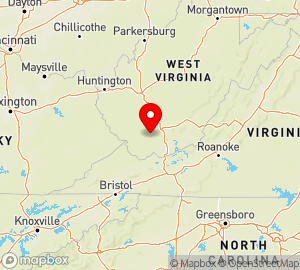West Virginia
West Virginia State Information

www.wv.gov
Area (sq mi):: 24229.76 (land 24077.73; water 152.03) Population per square mile: 75.50
Population 2005: 1,816,856 State rank: 0 Population change: 2000-20005 0.50%; 1990-2000 0.80% Population 2000: 1,808,344 (White 94.60%; Black or African American 3.20%; Hispanic or Latino 0.70%; Asian 0.50%; Other 1.30%). Foreign born: 1.10%. Median age: 38.90
Income 2000: per capita $16,477; median household $29,696; Population below poverty level: 17.90% Personal per capita income (2000-2003): $21,900-$24,542
Unemployment (2004): 5.30% Unemployment change (from 2000): -0.20% Median travel time to work: 26.20 minutes Working outside county of residence: 31.40%
List of West Virginia counties:
West Virginia Parks
- US National Parks
- State Parks
- Parks and Conservation-Related Organizations - US
- National Wildlife Refuges
- National Trails
- National Scenic Byways
- National Heritage Areas
- National Forests
West Virginia
Thirty-fifth state; admitted on June 20, 1863
The centennial celebration took place throughout the state during the year of 1963 with parades, pageants, sporting events, historical exhibits and reenactments, various arts contests, musical events, fireworks, and, on June 20 at the capitol in Charleston, a speech by President John F. Kennedy.
SEE ALSO WEST VIRGINIA DAY
State capital: Charleston Nickname: The Mountain State State motto: Montani Semper Liberi (Latin “Mountaineers
are always free”) State animal: Black bear (Ursus (Euarctos) americanus) State bird: Cardinal (Cardinalis cardinalis) State butterfly: Monarch State colors: Old gold and blue State fish: Brook trout (Salvelinus fontinalis) State flower: Great laurel or Rhodondendron (Rhododen
dron maximum) State fruit: Golden delicious apple State gem: Mississippian Fossil Coral (Lithostrotionella) State insect: Honeybee (Apis mellifera) State soil: Monongahela Silt Loam State songs: “The West Virginia Hills”; “West Virginia, My
Home Sweet Home”; “This Is My West Virginia” State tree: Sugar maple (Acer saccharum)
More about state symbols at:
www.wvtourism.com/spec.aspx?pgID=77 www.legis.state.wv.us/Educational/Kids_Page/kids.html
More about the state at:
www.wv.gov/sec.aspx?pgID=27 www.wvtourism.com/spec.aspx?pgID=3
SOURCES:
AmerBkDays-2000, p. 460 AnnivHol-2000, p. 103 DictDays-1988, p. 130
STATE OFFICES:
State web site: www.wv.gov
Office of the Governor State Capitol Bldg 1900 Kanawha Blvd E Charleston, WV 25305 304-558-2000 fax: 304-342-7025 www.wvgov.org
Secretary of State 1900 Kanawha Blvd E Bldg 1 Suite 157K
Charleston, WV 25305
304-558-6000
fax: 304-558-0900
www.wvsos.com
West Virginia Library Commission
1900 Kanawha Blvd E
Charleston, WV 25305
304-558-2041
fax: 304-558-2044
www.librarycommission.lib.wv.us
Legal Holidays:
West Virginia
a state in the eastern USA. Area, 62,600 sq km; population, 1,744,000 (1970), 39 percent urban. Its administrative center is Charleston.
West Virginia is situated within the Allegheny Plateau. The terrain is rugged and slopes westward (with elevations reaching as high as 1,481 m) to the Ohio River Valley (with elevations of 250-300 m). The climate is moderate, warm, and moist. The average January temperature ranges from —1° to 5°C, the average July temperature from 23° to 25°C. Annual precipitation is 900-1,250 mm.
Coal mining is one of the bases of the state’s economy (146 million tons in 1968; first in the USA). The prolonged stagnation of the coal industry has made West Virginia a “poverty region” with chronic mass unemployment and a loss of population (in 1950 the population was 2 million). Petroleum, natural gas, salt, and building materials are also extracted here. In 1969, 47,000 persons were employed in mining and 130,000 in processing. The major industries are ferrous metallurgy and by-product coke (Weirton), aluminum industry (Ravenswood), synthetic fibers, plastics, and synthetic rubber (Charleston), and silicate-ceramic goods (glass, porcelain, and building materials in Wheeling). The capacity of the state’s electric power plants is 5.8 million kilowatts (1968); some of the power produced here is transmitted to other states.
Agriculture is dominated by subsistence farms. Small-scale farmers are being ruined; the number of farms fell from 99,000 in 1940 to 34,000 in 1964 (and of these only 13,000 produced for market). More than three-fourths of commercial production is provided by livestock raising, including poultry. In 1970 there were 475,000 cattle and 71,000 pigs. In the valleys of the Appalachians gardens and orchards, mainly apple orchards, have been developed. There are 5,000 km of railroads and 60,000 km of roads. Of great importance is the haulage, primarily of coal, along the Ohio River and its tributary the Monongahela.
V. M. GOKHMAN